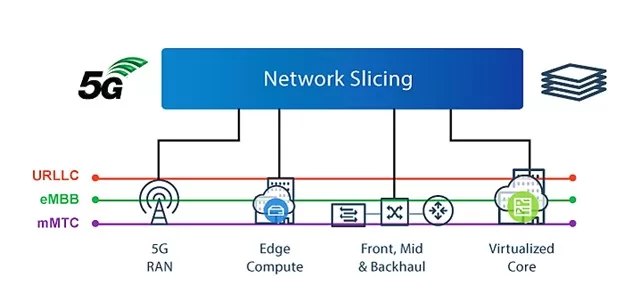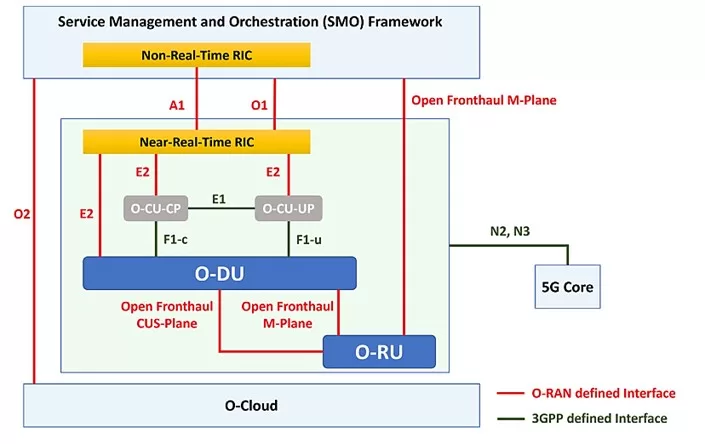Introduction
The paradigm shift from 4G to 5G networks has been marked by an unprecedented transformation in the way mobile communication systems are structured and managed. At the heart of this revolution is the concept of Radio Access Network (RAN) slicing, a dynamic and flexible approach to network management that has become integral to the vision of 5G. RAN slicing allows network operators to carve out specific ‘slices’ of their network infrastructure to cater to diverse service requirements, ranging from high-speed data services to massive IoT deployments. This technology promises to offer tailored network capabilities that align precisely with the needs of different applications, devices, and services.

Figure 1: RAN Slicing Illustration
With the advent of 3GPP Release 18, the evolution of RAN slicing has taken a leap forward, integrating the principles of openness and intelligence championed by the O-RAN Alliance. This new release ushers in a suite of enhancements that aim to streamline network functions and broaden the horizons for network customization and efficiency. Central to this advancement is the role of Artificial Intelligence (AI), which is poised to redefine the management of RAN slices by introducing levels of adaptability, automation, and performance optimization previously unattainable.
This article aims to explore the transformative impact of AI on RAN slicing, examining its potential to optimize network resource allocation, ensure quality of service (QoS), and respond dynamically to fluctuating network demands.
O-RAN’s Vision for RAN Slicing
The Open Radio Access Network (O-RAN) Alliance’s vision for Radio Access Network (RAN) slicing represents a transformative step in wireless network architecture and efficiency. By redefining the approach to RAN management, O-RAN introduces a new paradigm where flexibility, openness, and intelligence converge to form a more dynamic and user-centric network.

Figure 2: Open RAN Architecture
At its core, RAN slicing in O-RAN architecture revolves around the concept of creating multiple virtual networks, each tailored to meet specific service requirements, over a common physical infrastructure. This approach allows for a more efficient utilization of network resources, catering to a diverse range of applications from high-speed data services to IoT connectivity.
O-RAN’s contribution to RAN slicing is significant. It introduces standardized interfaces and protocols that break the traditional vendor-specific barriers, allowing for greater interoperability and flexibility in network deployments. This standardization also enables a diverse ecosystem of solution providers to contribute to the RAN space, fostering innovation and competition.
One of the key aspects of O-RAN’s vision for RAN slicing is the integration of AI and machine learning technologies. These technologies enable the network to intelligently manage and allocate resources based on real-time data, user demand, and network conditions. AI-driven RAN slicing can dynamically adjust network parameters to optimize performance, ensuring efficient resource usage and enhanced user experiences.
AI enabling evolved RAN Slicing
AI is increasingly becoming the backbone of RAN slicing, particularly in the context of the ORAN architecture. AI’s integration into RAN slicing is revolutionizing the way networks are managed and optimized, offering unprecedented levels of efficiency and customization.
Through advanced algorithms and data analytics, AI systems can analyze traffic patterns, user behavior, and network conditions in real-time. This analysis allows for the automatic adjustment of network parameters and resources across different slices to ensure optimal performance and resource utilization.
Enhancing Network Efficiency and Adaptability
AI-driven RAN slicing enhances network efficiency by predicting and preemptively addressing network demands. This preemptive approach reduces resource wastage and ensures that each network slice operates at peak efficiency. Moreover, AI’s predictive capabilities enable the network to adapt swiftly to changing conditions, such as sudden spikes in data traffic or shifts in user distribution.
Customization and Quality of Service
AI enables the customization of network slices to cater to specific service requirements. For instance, AI algorithms can allocate more bandwidth to data-intensive applications, such as video streaming, while ensuring low latency for critical services like autonomous driving. This level of customization ensures that each service within a slice meets its specific Quality of Service (QoS) requirements.
Network Slicing in a Multi-Vendor Environment
In an O-RAN ecosystem, where networks comprise hardware and software from multiple vendors, AI facilitates seamless integration and management of these diverse components. AI-driven orchestration tools can manage and optimize resources across different vendors’ equipment, ensuring coherent operation and maximizing the benefits of a multi-vendor environment.
Technical Challenges and AI-Driven Solutions
While AI brings numerous advantages to RAN slicing, it also presents challenges. One of the primary challenges is the complexity involved in training AI models to accurately predict and manage network conditions.
These challenges stem from the complexity of managing a dynamic, multi-vendor, and AI-powered network environment.
Handling Network Complexity
The first major challenge is the inherent complexity of RAN slicing in a multi-vendor environment. Managing multiple slices, each with distinct requirements and characteristics, demands a high level of precision and efficiency.
Advanced AI algorithms can manage this complexity by analyzing vast data sets from different network slices and vendors. These algorithms can optimize resource allocation and slice configuration in real-time, adapting to changing network conditions and user demands.
Ensuring Real-Time Decision Making
RAN slicing requires decisions to be made in real-time or near real-time to ensure optimal network performance and QoS.
AI systems can process large volumes of data at high speeds, enabling real-time analysis and decision-making. Machine learning models, especially those based on reinforcement learning, can make quick adjustments to network parameters, ensuring efficient resource utilization and maintaining QoS.
Data Privacy and Security
The use of AI in network management raises concerns regarding data privacy and security, particularly when handling sensitive user data.
Implementing robust encryption methods and secure data-handling protocols is crucial. Additionally, AI can be employed to enhance security measures, such as anomaly detection systems that identify and mitigate potential threats in real-time.
AI-Enhanced Resource Allocation and Multi-Vendor Flexibility in RAN Slicing
In the evolving 5G landscape, two aspects are crucial: intelligent resource allocation through AI in RAN slicing and the strategic benefits of a multi-vendor approach.

Figure 3: Network slicing in ORAN using multi-vendors
AI in Resource Management: AI and ML technologies are transforming resource allocation in RAN slicing, essential for managing diverse 5G services like eMBB, URLLC, and mMTC. AI’s predictive analytics optimally distribute resources across network slices, adapting to changing demand patterns.
Advantage of Multi-Vendor Environments: The multi-vendor approach in RAN slicing offers flexibility and choice, breaking free from vendor lock-in.
The incorporation of multi-vendor elements, as depicted in the figure, highlights the operational flexibility of Open RAN. By selecting specialized components from different vendors, network operators can assemble a RAN infrastructure that is not only resilient but also fine-tuned for optimal performance. Vendor A’s O-RU, for instance, may excel in interfacing with existing technologies, while Vendor B’s and Vendor C’s distributed and central units could bring cutting-edge advancements in user plane and control plane functionalities.
This diversity allows service providers to leverage specific strengths of different vendors, enhancing innovation and cost-effectiveness.
Synergizing AI and Multi-Vendor Strategies: Combining AI-driven resource optimization with a multi-vendor setup result in a more robust and agile network. AI algorithms can tailor resource allocation to suit the performance characteristics of each vendor’s equipment, ensuring seamless network functionality.
The transition to such an integrated network infrastructure is not without challenges. It requires a concerted effort in interoperability testing, ensuring that all components from different vendors work in concert. Additionally, the network must be agile enough to adapt as AI models evolve and as new vendor technologies emerge. This calls for an open standardization that fosters collaboration while fueling innovation across the 5G spectrum.
Conclusion
In conclusion, the integration of AI in RAN slicing, as highlighted in 3GPP Release 18, signifies a major advancement in 5G networks. This technological synergy not only enhances resource allocation through intelligent adaptability and automation but also introduces the resilience of a multi-vendor environment.
As we move towards a more connected future, AI stands as the cornerstone of RAN slicing, ensuring that network operators can deliver bespoke quality of service across a myriad of applications. The multi-vendor approach further propels this vision by providing the freedom to choose the best-in-class components, fostering an ecosystem ripe for innovation and economic efficiency.
However, the path forward will require rigorous standardization and testing to ensure interoperability and to embrace the continuous evolution of technology. The future of mobile networks, thus, rests on the shoulders of AI’s capability to manage complexity and on the industry’s willingness to adopt a collaborative and open approach to network architecture.
References
- Lin, “Artificial Intelligence in 3GPP 5G-Advanced: A Survey”, IEEE Communications Society, 2023.
- Bega, D., et al. Network slicing meets artificial intelligence: an AI-based framework for slice management. IEEE communications magazine, 58(6), June 2020, Pp. 32-38 DOI: https://doi.org/10.1109/MCOM.001.1900653
- O-RAN WG1 Slicing Architecture (https://www.o-ran.org/specifications)
- 3GPP TS 38.843, “Study on Artificial Intelligence (AI)/Machine Learning (ML) for NR air interface”, Release 18, 2023.
- 3GPP TS 23.288, “Architecture enhancements for 5G system (5GS) to support network data analytics services,” V17.9.0, 2023.

